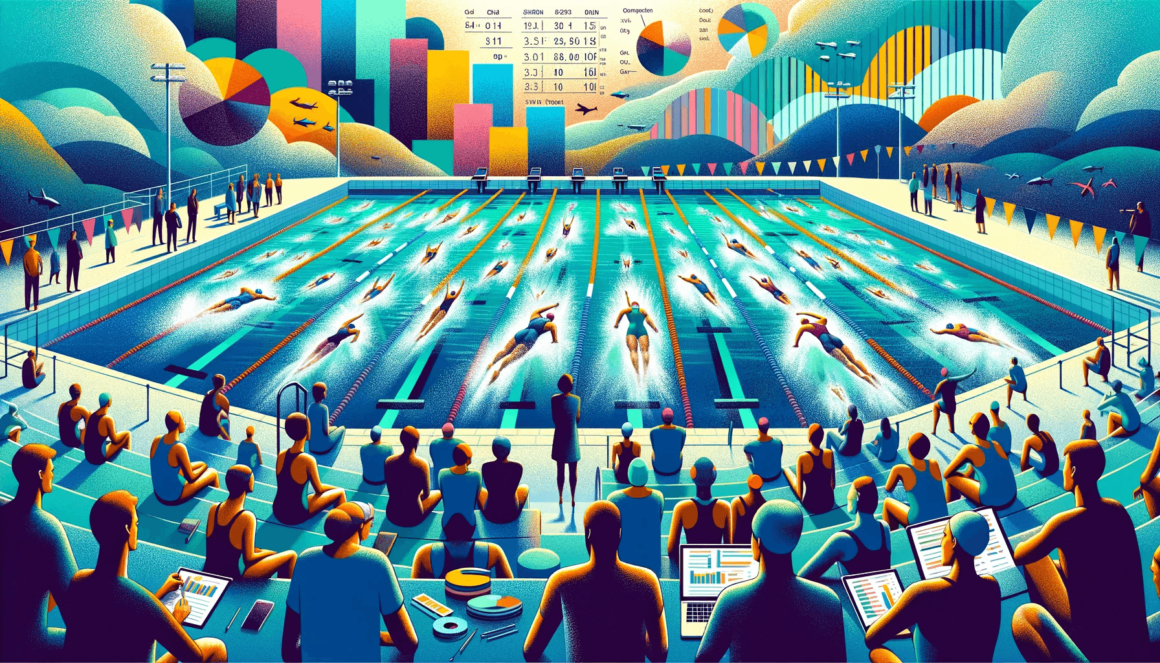17 Swimming Statistics to Know in 2024
As the fourth most popular sport ranked by the US by the Centre for Disease Control and Prevention (US-CDC) board, swimming has its appeal for both athletes and the general public.
Growth is imminent as the sports world continuously shines the limelight upon the swimming industry.
Below are several essential statistics about the swimming industry’s current market size, growth rate, viewership number and demographics, and some interesting statistics about competitive swimming.
Highlights of the Article
- Globally, 44% of the population, ages 15 and up, can swim. At an average of 97%, Northern European countries have the most number of swimmers.
- From 2016-2021, the viewer count for the US Olympic Swimming Trial decreased from 6.7 million to 2.7 million.
- The all-time record for the highest viewer count of the FINA World Aquatics Championship was 4.5 billion in 2013.
- Competitive swimming is followed by 34% of Americans, gaining the top spot worldwide.
- Women follow swimming 4% more than men, at 37% worldwide.
- Olympic swimming records are at least 83.035% faster than FINA World Championship records.
- At least 8 years of competitive experience is needed by swimmers to reach the performance peak of >900 FINA points.
- Olympic records for 100-meter freestyle leagues in men’s (58.6 seconds) and women’s (59.9 seconds) divisions are neck and neck.
- Eric “The Eel” holds the slowest 100-meter freestyle record at 1 minute and 52 seconds.
How Big is the Swimming Industry?
The 2020 global swimming pool industry was valued at $21.52 billion and is expected to reach $36.70 billion by 2028. Swimming pools will continue to grow as more individuals take up the sport and hobby.
The US home and public pool construction sector earned $11 billion, making it one of the top contributors to the global swimming pool industry.
This article will focus on the statistics surrounding them.
Swimming Industry Statistics

Whether as a life skill, recreational hobby or to participate in professional competitions, swimming applies to everyone across the globe.
Check out the statistics surrounding the sport’s worldwide reach, frequency, prevalence, and growing swimming pool market.
1. 44% or 2.7 billion worldwide population aged 15 and up can swim unassisted – mostly men.
(News Gallup)
Analysis of the demographic of swimmers in 142 countries found that only 44% of adults and adolescents can swim unassisted. This statistic equates to 2.7 billion people – 6 out of every 10 of whom are men.
Men are likelier to swim unassisted in higher-income countries in Northern and Western Europe, Australia, and New Zealand.
On the other hand, low-income countries located in Central Asia have the widest gender gap in adults who can swim.
| Location | % of Men Who Can Swim Unassisted | % of Women Who Can Swim Unassisted |
| Worldwide | 57% | 32% |
| Central Asia | 79% | 31% |
| Middle East | 61% | 28% |
| Southeast Asia | 64% | 28% |
| North/West Europe | 89% | 85% |
| Northern America | 89% | 78% |
| Australia/New Zealand | 90% | 85% |
The numbers show there are more factors behind the likelihood of people swimming worldwide – ones that must be considered in studying the reach of the swimming industry.
2. An estimated 4.7 million adults worldwide swim at least twice a month.
(Swim England, Harris Interactive, Live Strong)
The frequency of swimming varies on location. According to Swim England, about 4.7 million adults engage in swimming at least two times a month, or about 10.5% of the overall population.
The sport is particularly famous among women, with about 2.7 million who swim at least twice a month (11.7% of the female population).
Harris Interactive ranked Swimming with a sports index of 212 across the UK, the second most engaged with and followed in the area, with 31% of Britons swimming weekly.
In the US, Live Strong found that 31% (91 million) of Americans swim at least once a year. About 15% of adults and 35% of children swim more than six times a year.
3. Sweden, Netherlands, Norway, and Finland have the most swimmers aged 15 and older, averaging 97%.
(Organization for Economic Co-operation and Development)
Northern European countries like Sweden, Netherlands, Norway, and Finland have the highest number of people who can swim unassisted worldwide, with an average of 97% for the region.
Here’s the distribution for the number of swimmers per country.
- About 98% of Sweden and the Netherlands’ population aged 15 and up can swim.
- About 97% of Norway’s population aged 15 and older can swim.
- About 96% of Finland’s population aged 15 years and up can swim unassisted.
The region incorporates swimming into its educational system to combat the inequalities surrounding learning the skill – a seemingly effective approach from which more countries could learn.
4. On average, the Instructor-to-Learner ratio for swimming is 1:6 but varies according to factors.
(ASCTA, Safety Training Awards UK)
The Safety Training Awards organization in the UK identified 1 instructor to every 6 swim learners as the ideal ratio for the sport.
The recommendation is subject to risk assessments according to environmental factors, the learner’s skill level and background, and the instructor’s experience and expertise.
Similarly, the Australian Swimming Coaches and Teachers Association (ASCTA) created a matrix for the best instructor-to-learner ratio for swimming.
| Learner’s Age | Instructor-to-Learner Ratio |
| Newborn to 4 months old | 1 caregiver to 1 newborn (Preferably Home Education Program) |
| 4 months to 3 and ½ years old | 1 caregiver to 1 toddler *Maximum of 7 caregiver-toddler pairs for every 1 Swimming Instructor |
| 3 and ½ to 5 years old | For shallow water teaching: 1 instructor for every 5 preschoolers For deep water teaching:1 instructor for every 1 preschooler For varied water depth teaching:1 instructor to every 4 preschoolers |
| 5 to 12 years old | For teaching learners with little to no swimming skills: 1 instructor to every 10 learners For teaching learners with basic swimming skills: 1 instructor to every 12 learners For teaching learners with advanced swimming skills: 1 instructor to every 15 learners |
| 13 to 17 years old | For teaching learners with basic swimming skills: 1 instructor to every 10 learners For teaching learners with proficient swimming skills:1 instructor to every 25 learners |
The matrix is heavily influenced by age since it’s one of the strongest indicators for the learner’s skill level and ability to tread water independently.
5. The global swimming pool market will grow at 2.67% CAGR for 2021-2026.
(PR Newswire)
Recent statistics project positive growth for the swimming pool industry in 2021-2026. With a CAGR of 2.67%, the market predicts more business and job opportunities produced and an overall profitable investment scene.
Large-scale urbanization and tourism are the drivers for the growth. Modernization is bringing over pools to small cities, and with them being a big hit in the tourism market, the swimming pool industry will flourish.
Swimming Viewership Statistics
One of the ways the swimming industry generates revenue is by broadcasting competitions like the Olympics, World Aquatic Championships, and the FINA Swimming World Cup.
Here are the statistics surrounding the number of people who watch competitive swimming matches.
6. US Olympic Swimming Trial’s viewer count decreased from 6.7 million in 2016 to 2.7 million in 2021.
(Swimming World Magazine, Swim Swam)
The Swimming Trials averaged a 6.7 million viewer count in 2016. However, recent statistics show that NBC Network’s viewership for the 2021 Swimming Trials only hit the 2.7 million mark – a low number compared to previous records.
The Trial’s viewer count peaked on the last day of the competition’s coverage with a record of 4.905 million.
According to Swim Swam, viewership for competitive swimming declined over the years as more people engaged in cord-cutting in favor of online streaming – a feature not as readily accessible in 2016 as today.
7. FINA World Aquatics Championship’s highest viewer count was 4.5 billion in 2013.
(Swimming World Magazine)
FINA gained its highest viewership in the competitive swimming industry in 2013. It was a 2-week event broadcasted globally and reached a ground-breaking 4.5 billion viewer count.
The record covered all six aquatic disciplines of swimming, open water swimming, water polo, synchronized swimming, diving, and high diving – made possible by 5,156 coverage hours.
To this day, FINA holds this as its highest viewer count record.
8. 34% of Americans follow swimming as a sport – the highest in the world.
(YouGov Sport)
The US holds 552 Olympic swimming medals, making it one of the world’s Olympic powerhouses.
It’s no surprise that Swimming is the second most followed sport in the US, at 30%. Meanwhile, 35% of Americans are engaged in Diving, another aquatic discipline.
Swimming Viewer Demographic
Data shows swimming is most popular in North America, Chile, the UK, Hungary, Australia, and Singapore. Considering Swimming’s extensive history in England and its spread worldwide since then, it can be regarded as a global sport.
Here are the statistics breaking down the demographics of Swimming’s audience.
9. Swimming is among the top 5 most followed sports in Olympic powerhouses Germany, the UK, the US, and China.
(YouGov Sport)
Swimming is among the top 5 most followed sports in the four Olympic powerhouses (Germany, US, UK, and China).
The table below shows details for each country’s percentage of swimming sports followers, the rank of the sport in that country, and their total number of Olympic swimming medals.
| Country | Ranking | % of Swim Sport Followers | # of Olympic Swimming Medals |
| Germany | 3rd most followed sport | 30% | 58 medals |
| United Kingdom | 2nd most followed | 32% | 74 medals |
| United States | 2nd most followed | 34% | 575 medals |
| China | 4th most followed | 23% | 49 medals |
The percentage of people following the sport refers to individuals who actively read about, and watch events and competitions surrounding the sport.
The Olympic powerhouses are also among the sport’s most active and involved countries. Germany hosted the FINA Swimming World Cup in 2022, while China hosted the previous year.
As the origin of competitive swimming, the UK has several programs for Olympic Swim athletes to promote the sport to the public. Meanwhile, China’s population is still learning the skill despite its strong line of athletes.
10. Globally, women (37%) follow swimming more than men (33%).
(YouGov Sport)
Experts initially found that women favored individual sports while men favored team sports.
Swimming closed the gender gap for sports types, with 37% of women and 33% of men following the sport. The 4% difference makes swimming one of the few sports to catch the attention of both demographics.
11. Most (381,000) International Swimming League viewers are young at ages 2-17.
(Swimswam)
The debut of the International Swimming League on US television confirmed that most of its viewers are young.
Ratings showed that about 381,000 of its viewers were between ages 2-17, and only 102,000 viewers belonged to the ideal 18-49 age demographic.
TV networks often target the latter demographic since they believe they have more disposable income – making them an ideal marketing audience.
12. Swimming is most famous among 18-34 years old (50%) in the UK and least favored among individuals 55 (31%) and older.
(Harris Interactive)
Younger audiences are more dedicated to watching and following swimming competitions than older demographics.
Details on the distribution of swim viewers across different age groups are as follows:
- About 50% of Britons aged 18-34 follow swim competitions.
- Around 34% of Britons aged 35-44 watch swim competitions.
- Only 31% of Britons aged 55 and above follow swim competitions.
The sport is more followed through live TV broadcasting rather than in-person meets.
Competitive swimming broadcasts attract more women (40%) than men (36%), carrying the potential for wider viewership if the sport is given more media coverage than the regular Olympic games.
Competitive Swimming Statistics
The competitive Swimming industry is booming due to growing interest in the sport. Statistics show that the number of USA Swimming Members has increased.
In 2009, 286,147 year-round athletes engaged in the sport. By 2019, the number of year-round athletes was 327,337 – proving that competitive swimming is gaining more and more interest.
Here are a few more statistics regarding the records set and the demographics in the competitive swimming industry.
13. Olympic records are faster than FINA World Championship records by 83.035%.
(Swimswam)
Researchers compared records between the FINA World Championship and the Olympics.
Studies found that FINA’s records were 31.73% faster. Meanwhile, Olympic event records were 83.035% faster than FINA’s – proving the significance of Olympic records in the swimming industry.
Below are the records considered:
- The Gold and Bronze records from four FINA World Championship events:
- Budapest, Barcelona, Montreal, Fukuoka
- The Olympic events in:
- Tokyo, Rio, London, and Athens
14. Competitive swimmers need at least eight years of experience to reach peak performance (>900 FINA points).
(BMC Research Notes)
Analysis of the records and demographics of 588,938 swimmers helped find the optimal competition age. In this case, peak performance equates to the athletes’ ability to reach >900 FINA points.
Data confirmed that swimmers reached peak performance after eight years of competitive swimming experience.
Results from this analysis rejected the general assumption that athletes are likelier to peak in their early years for their respective sports.
15. World records for 100-meter freestyle leagues are neck and neck for men’s (58.6 seconds) and women’s (59.9 seconds) divisions.
(Swimming World Magazine)
The all-time world records for 100-meter freestyle leagues remain unbroken after dipping below the minute mark in the 1990s.
Dawn Frasier bagged the gold at 59.9 seconds in 1962 and was the first woman to break the minute barrier for this category – cementing her spot among the world records.
Forty years before that, Johnny Weissmuller was the first swimmer to break the minute mark at 58.6 seconds for the category. Both world records set the swimming industry’s golden standard and opened doors for further improvement for all athletes.
16. Eric “The Eel” holds the slowest 100-meter freestyle record at 1 minute and 52 seconds.
(Swimming World Magazine)
The record for the slowest 100-meter freestyle finisher belongs to Eric Moussambini from Equatorial Guinea.
He ranked last of the 71 athletes in his category, finishing at 1:52.72. Spectators during the Sydney Olympic Games in 2000 cheered on Eric despite the rank and dubbed him “Eric the Eel” afterward.
17. Paula “The Crawler” holds the slowest 50-meter freestyle record at 1 minute and 3 seconds.
(Swimming World Magazine)
Paula Barila Bolopa holds the record for the slowest 50-meter freestyle finish.
The Equatorial Guinea native finished the 50-meter lap at 1:03.97, ranking last among the 73 athletes for the league – earning her the nickname “the Crawler” at the Sydney Olympic Games in 2000.
The Equatorial Guinea athletes had little to no support in training or resources – making their records and placements second to their success at the Olympics.
Bottom Line
Swimming has a long future ahead of it. With the growing fanbase and market size, it’s sure to open up doors for opportunities both for business and competitive swimming.
Safeguarded by the many institutions that work for the safety and progress of the industry, swimming will continue to inspire many young athletes who want to be a part of the industry.
FAQs
What are some statistics and data about people who know how to swim?
About 54% of Americans and 80% of Australians have poor swimming skills, but about 95.5% of Icelandic people can swim.
What are the statistics of pools?
Statistics show that 15% of American households have personal swimming pools. There are 10.7 million pools in the US – 10.4 million of which are residential and 309,000 for public access.
What percentage of people go swimming?
The US CDC estimates about 31% of Americans swim yearly. About 15% of adults swim at least six times a year, while 36% of children swim at the same frequency.
How many people swim for exercise?
The number of people who swim for fitness reasons varies. Statistics confirmed that about 28.4 million people swim in the US. There’s a decrease in the number in England (4 million) and Singapore (6 million).
 BC.Game
BC.Game  7Bit
7Bit  Ducky Luck
Ducky Luck  Red Dog
Red Dog